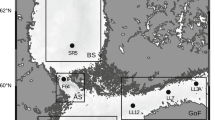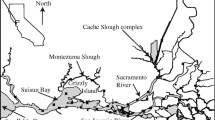Abstract
Biological monitoring of aquatic biota is used to assess the impact of changes in the environment. Critical to the development of a sound biological monitoring protocol is the judicious selection of organisms and organism characteristics to be monitored. Accurate interpretations of change necessitate description of the natural variability of the system. We introduce a state-space model for compositional monitoring data, and illustrate how one can incorporate spatial structure and covariates to assess natural variability. The methods are illustrated on benthic survey data from Delaware Bay, and applied to proportional composition at the genus level. The distribution of benthic macroinvertebrates in Delaware Bay depends significantly on salinity. There is residual spatial dependence in the data after accounting for the salinity effect.
Similar content being viewed by others
References
Aitchison, J. (1982) The statistical analysis of compositional data (with discussion). Journal of the Royal Statistical Society Series B., 44, 139–77.
Aitchison, J. (1986) The Statistical Analysis of Compositional Data. Chapman & Hall, New York.
Aitchison, J. and Shen, S.M. (1980) Logistic-normal distributions: some properties and uses. Biometrika, 67, 261–72.
Aschan, M. (1990) Changes in softbottom macrofauna communities along environmental gradients. Ann. Zool. Fennici 27, 329–36.
Besag, J.E. (1974) Spatial interaction and the statistical analysis of lattice systems (with Discussion). Journal of the Royal Statistical Society Series B, 36, 192–236.
Besag, J.E., Green, P.J., Higdon, D.M. and Mengersen K. (1995) Bayesian computation and spatial systems (with Discussion). Statistical Science, 10, 3–66.
Billheimer, D.D. and Guttorp, P. (1995) Spatial statistical models for discrete compositional data. Technical Report, Dept. of Statistics, University of Washington, Seattle.
Deegan, L.A., Finn, J.T., Ayvasian, S.G. and Ryder, C. (1993) Feasibility and application of the index of biotic integrity to Massachusetts estuaries (EBI) Final Project Report to Massachusetts Executive Office of Environmental Affairs, Department of Environmental Protection, North Grafton, MA.
Dennis, B., Patil, G.P. and Rossi, O. (1979) The sensitivity of ecological diversity indices to the presence of pollutants in aquatic communities. In Environmental Biomonitoring, Assessment, Prediction, and Management, (ed. Cairns, J. Jr., Patil, G.P. and Waters, W.E.), pp. 379–413, International Cooperative Publishing House, Burtonsville, MD
Fore, L.S., Karr, J.R., and Wisseman, R.W. (1995) A benthic index of biotic integrity for streams in the Pacific northwest. Submitted for publication.
Geman, S. and Geman, D. (1984) Stochastic relaxation, Gibbs distributions and the Bayesian restoration of images. IEEE Transaction of Pattern Analysis and Machine Intelligence, 6, rm 721–741.
Guttorp, P. (1993) Statistical analysis of biological monitoring data. In G.P. Patil, C.R. Rao (eds) Multivariate Environmental Statistics, 165–74. Amsterdam: North-Holla
Gray, J.S. and Pearson, T.H. (1982) Objective selection of sensitive species indicative of pollution-induced change in benthic communities. I. Comparative methodology, Mar. Ecol. Prog. Ser., 9, 111–19.
Hastings, W.K. (1970) Monte Carlo sampling methods using Markov chains and their applications. Biometrika 57, 97–109.
Karr, J.R. (1981) Assessment of biotic integrity using fish communities. Fisheries 6, 21–27.
Karr, J.R. (1995) Ecological integrity and ecological health are not the same. In P. Schulze (ed.) Engineering within ecological constraints. National Academy of Engineering. Washington: National Academy Pre
Kass, R.E. and Raftery, A.E. (1995) Bayes factors. Journal of the American Statistical Association, 90, 773–795.
Mardia, K.V. (1988) Multidimensional multivariate Gaussian Markov random fields with applications to image processing. Journal of Multivariate Analysis 24, 265–84.
Marmorek, D.R., Bernard, D.P. and Ford, J. (1988) Biological monitoring for acidification effects: U.S.-Canadian workshop. U.S. Environmental Protection Agency Report. Environmental Research Laboratory, U.S. Environmental Protection Agency. Corvallis, Oregon. Metropolis, N., Rosenbluth, A.W., Rosenbluth, M.N., Teller, A.H. and Teller E. (1953) Equations of state calculations by fast computing machines. Journal of Chemical Physics 21, 1087–92.
Overton, W.S., White, D. and Stevens, D.K. (1990) Design Report for Emap: Environmental Monitoring and Assesment Program. EPA/600/3-91/053, US Environmental Protection Agency, Washington, DC.
Patrick, R. (1972) Aquatic communities as indices of pollution. In Indicators of Environmental Quality, (ed. Thomas, W.A.), pp. 93–100. Plenum Press, New York
Pollard, J.H. (1975) Mathematical Models for the Growth of Human Populations. Cambridge Univeristy Press, Cambridge.
Raftery, A.E. and Lewis, S.M. (1992) How many iterations in the Gibbs sampler-In Bayesian Statistics 4. (ed. Bernardo, J., Berger, J., Dawid, A.P. and Smith, A.F.M.). Oxford University Press, pp. 765–76
Raftery, A.E. and Lewis, S.M. (1995) The number of iterations, convergence diagnostics and generic Metropolis algorithms. In Practical Markov Chain Monte Carlo (ed. Gilks, W.R., Spiegelhalter, D.J. and Richardson, S.) Chapman & Hall, London
Schindler, D.W., Mills, K.H., Malley, D.F., Findlay, D.L., Shearer, J.A., Davies, I.J., Turner, M.A., Linsey G.A. and Cruikshank, D.R. (1985) Long-term ecosystem stress: the effects of years of experimental acidification on a small lake. Science, 228, 1395–401
Schwinghammer, P. (1988) Influence of pollution along a natural gradient and in a mesocosm experiment on biomass-size spectra of benthic communities, Mar. Ecol. Prog. Ser. 46, 199–206.
Spellerberg, I.P. (1991) Monitoring Ecological Change. Cambridge University Press, Cambridge.
Warwick, R.M. (1986) A new method for detecting pollution effects on marine macrobenthic communities, Marine Biology, 92, 557–62.
Word, J.Q., Meyers, B.L. and Mearns, A.J. (1977) Animals that are indicators of marine pollution. In Annual Report 1977, Coastal Water Research Project. El Segundo, California.
Author information
Authors and Affiliations
Rights and permissions
About this article
Cite this article
Billheimer, D., Cardoso, T., Freeman, E. et al. Natural variability of benthic species composition in the Delaware Bay. Environmental and Ecological Statistics 4, 95–115 (1997). https://doi.org/10.1023/A:1018514226420
Issue Date:
DOI: https://doi.org/10.1023/A:1018514226420




